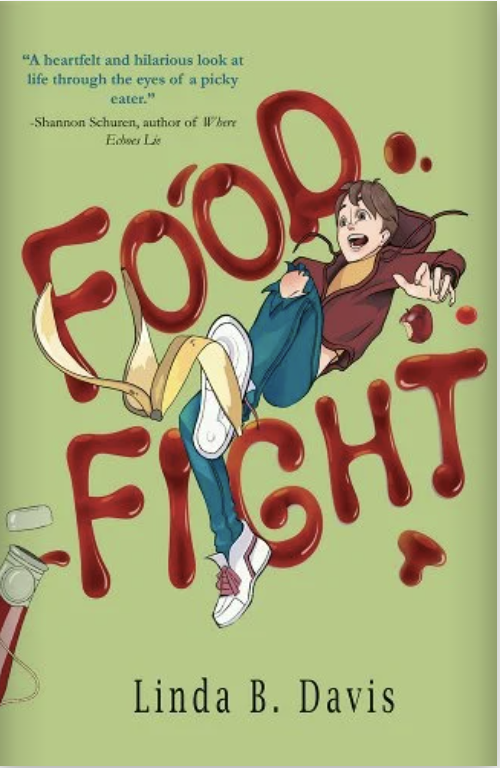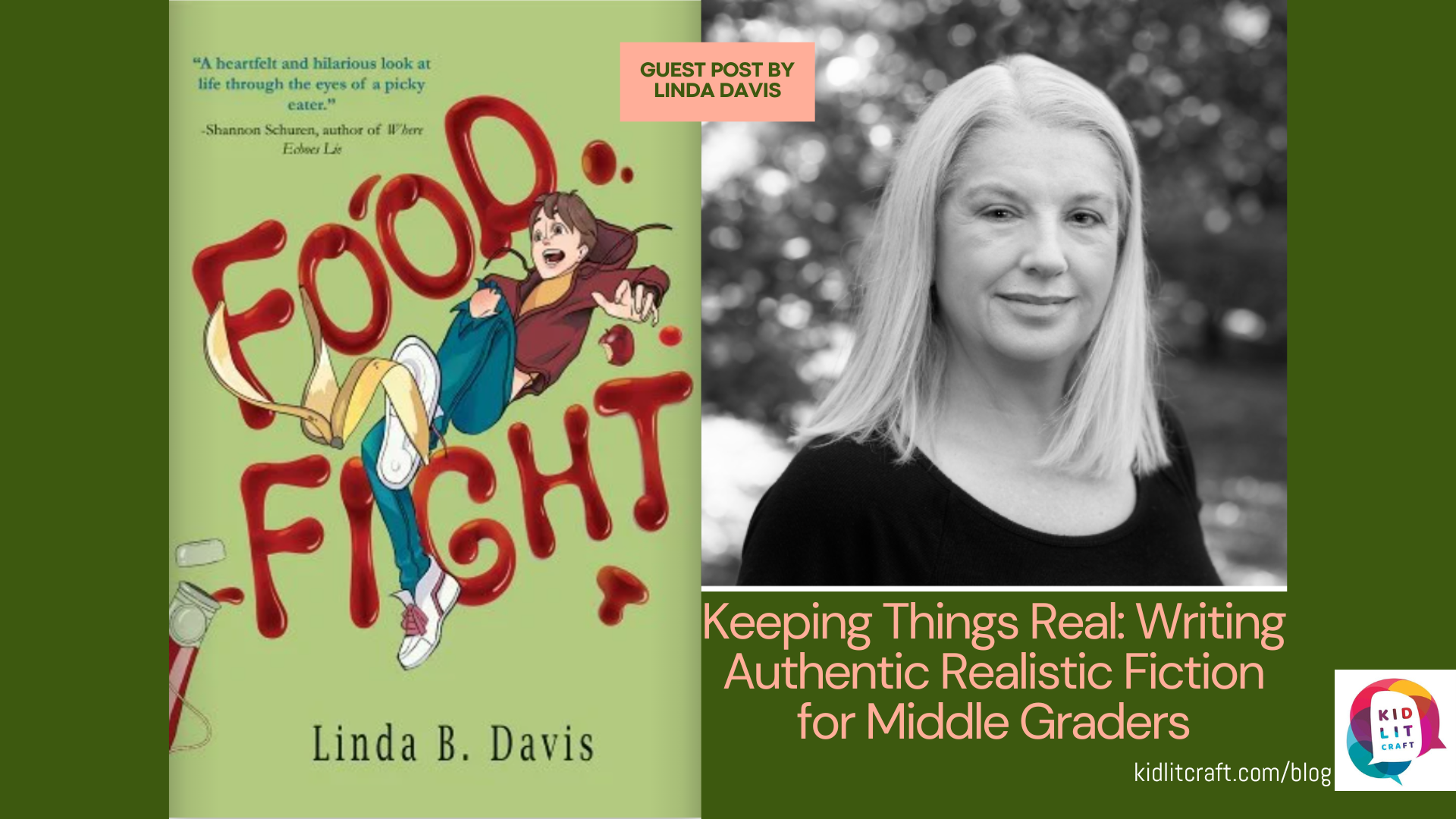guest post by Linda B. Davis

I recently observed a family of four decide where to sit on the patio of a seat-yourself restaurant. The son, who looked to be ten, chose a table in the sun. His younger sister, squinting dramatically, preferred a shady spot a few feet away. Their mom sided with the daughter at first, then changed her mind. They squabbled and switched tables at least four times before the father arrived with their tray of food. He had no patience for the debate and insisted that they sit together at the shaded table.
Watching this drama play out made me think about writing my debut middle grade novel, Food Fight—many scenes feature my main character, Ben Snyder, an eleven-year-old boy living with an eating disorder, as he manages situations related to food and eating, both with family and with peers.
But engaging middle school readers requires more than an interesting plot—the characters and their experiences must feel authentic to and reflective of the complicated world in which the readers live. This level of authenticity can be accomplished with realistic interpersonal interactions, authentic dialogue, a dynamic social context, and the layering of internal stressors with external conflict. Here are some hints I found helpful.
Create realistic interpersonal communication
Ben is living with ARFID (Avoidant/Restrictive Food Intake Disorder) an eating disorder often characterized as extreme picky eating. However, the reality is more complex and serious and can cause significant medical, social, and self-esteem issues. ARFID is a relatively rare condition. However, the types of challenges it presents are universal in the world of middle graders as they confront the never-ending question, How do I fit in?
Because Food Fight is told from Ben’s point of view, the reader has an intimate look at his experience—he’s being singled out and bullied because of his eating habits. But as writers, we can enrich a story by providing a sense of what motivates the other characters. We can show these character motivations by inference—in other words, through character reactions and observable physical signals.I’ve found The Emotion Thesaurus by Angela Ackerman and Becca Puglisi to be an extremely helpful resource when I need ideas for how to convey characters’ expressions and physical reactions in compelling and recognizable ways. One helpful point the authors make is that stronger emotions yield bigger reactions and less control over such actions, which can be unintentionally revealing. Just skimming the book’s categories of emotions will probably give you a wealth of ideas, not just for expressing the ways characters act and emote, but maybe even for whole scenes.
Use authentic dialogue
Dialogue—both Ben’s inner dialogue and the words spoken out loud—are windows into what’s driving him and the other characters in each situation. Clearly these words must feel authentic and realistic in order to keep readers engaged. I know that a sure-fire way to lose a reader is to use outdated or clumsy language in dialogue. One ongoing challenge for me in working on this story was to find authentic-sounding (and yet appropriate) insults beyond the word “jerk.”
I sometimes asked neighbors and their kids to review lists of words I think middle schoolers might use in real-life conversations. Generally, my lists came back from the kids with lines scratched through most of my ideas, but they’d also identify words that rang true for them.
We want the words our characters use to be distinctive without calling too much attention to themselves. I keep a running list on my phone of intriguing new words, as well as oldies but goodies I might otherwise forget. Exercises like these are a good way to focus on creating the smoothest, most realistic-sounding dialogue.
Put your characters in social contexts
One of my biggest challenges in writing this book about middle graders and for middle graders was in how to strike a balance between my main character’s inner world and what happens externally as he interacts with the other characters in the story. Ben’s eating disorder doesn’t exist in a vacuum, and I never wanted this to be a story limited to that topic. Ben is also dealing with issues typical for kids his age, such as a first crush, friendship changes, a bully, and an overnight class trip. Each of these situations is made more complicated by his eating disorder.
But Ben isn’t the only character on the page. To create a realistic and multi-dimensional world for Ben to exist in and interact with, my other characters had to have their own needs, wants, and agendas, too—even if the reader isn’t completely aware of what they are.Developing a whole host of characters can be a challenge! But an exercise that can really help is to “freewrite” a scene or two that might have absolutely nothing to do with the plot. Just start writing—with no particular agenda for the characters—until something interesting happens. Doing this always helps me learn more about the relationships between my characters—and it can produce little unexpected gems. For example, because so many scenes in Food Fight were focused on eating, I tried putting Ben and his peers in a skate park and in a tent to see what dynamics might change when there was no food. [Editor’s note: you can find more freewriting exercises here.]
Add external stressors on top of internal conflict
Food itself is not the only stressor for Ben when he’s in a situation where people are eating, such as the school cafeteria, a mixed-gender pizza party, the mall food court, or a family dinner. Ben’s anxiety about eating is intensified when his interactions with others become complicated and the stakes are high—whether he’s flirting with his crush over a shared plate of fries in the food court or defending himself from a bully’s verbal attack during dinner on an overnight class trip.
Sometimes I tried writing drafts of these scenes from another character’s point of view in order to gain a new perspective on how Ben might engage with his peers during conflicts. This exercise is an easy, and often enlightening, way to change things up when you want to learn more about any character in your story.
Give your stories a hopeful resolution
The other night I couldn’t help but consider what might happen if I dropped Ben and his family into the musical-chairs scenario I witnessed on that restaurant patio. Suddenly the power struggles over choosing a table for dinner took on a new meaning, and I considered the ways each person would try to assert themself.
I had expected the family to continue their bickering or to eat in angry silence, but I was wrong—they chatted and laughed while enjoying their meal. That unexpected change reminded me of the valuable advice I first heard from author and writing teacher Sarah Aronson at a recent SCBWI conference. She encouraged writers to think about crafting endings that are not only hopeful—a general guideline for middle grade fiction—but also surprising yet inevitable.
Surprising yet inevitable. For me, this is the new standard by which I evaluate every ending I watch, read or try to write. It can be a challenging task to tie up a story so it accomplishes both, but it’s worth the effort in aiming to get there. You might try experimenting with different possibilities, brainstorming with other fiction writers, or even deconstructing and reconstructing parts of your plot to establish just the right mix of surprise and inevitability. Your readers will come away from your story with that satisfying sense of the expected and the unexpected all wrapped up in one great finale.
Something a little unexpected at the end can be a bonus for your readers, even as it is in real life. I was pleasantly surprised and reassured by the ending of the story on the patio, and I’m hopeful that Ben has some more enjoyable meals in his future, too.

Linda B. Davis has always been curious about why we do the things we do. She holds master’s degrees in social work and developmental psychology. As a social worker in a community mental health setting, Linda became passionate about the need for accurate and accessible mental health information in children’s literature.
She is a member of SCBWI and is active in the Chicago writing community. In her free time, she enjoys traveling, gardening, buying more books than she can possibly read, and maintaining her Little Free Library. Food Fight is her first novel.
To learn more about her life and work, visit: www.lindabdavisauthor.com
For more information about ARFID please visit The National Eating Disorders Association or F.E.A.S.T.
Find Linda on social media:

COMMENTs:
0